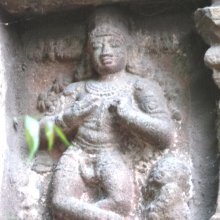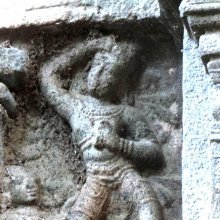Bhramari, Bhramarī, Bhrāmarī: 14 definitions
Introduction:
Bhramari means something in Buddhism, Pali, Hinduism, Sanskrit, Jainism, Prakrit. If you want to know the exact meaning, history, etymology or English translation of this term then check out the descriptions on this page. Add your comment or reference to a book if you want to contribute to this summary article.
Images (photo gallery)
In Hinduism
Vaishnavism (Vaishava dharma)
Source: Google Books: Lakṣmī Tantra: A Pāñcarātra Text“During the sixtieth era there will be one demon, called Aruṇa who will do much harm to men and sages. Then I shall appear in bee-form incorporating unnumerable bees, and I shall slay the mighty demon and rescue the three worlds. From then on people will praise me for ever and address me as Bhrāmarī.” (see the Lakṣmī-tantra 9.41-43, called “The exclusive incarnations of Śakti”)

Vaishnava (वैष्णव, vaiṣṇava) or vaishnavism (vaiṣṇavism) represents a tradition of Hinduism worshipping Vishnu as the supreme Lord. Similar to the Shaktism and Shaivism traditions, Vaishnavism also developed as an individual movement, famous for its exposition of the dashavatara (‘ten avatars of Vishnu’).
Yoga (school of philosophy)
Source: Google Books: The Khecarividya of AdinathaThe goddess Bhrāmarī (भ्रामरी) is associated with a pīṭha called Janasthāna (or, Jālasthāna) whose microcosmic location is the chin.

Yoga is originally considered a branch of Hindu philosophy (astika), but both ancient and modern Yoga combine the physical, mental and spiritual. Yoga teaches various physical techniques also known as āsanas (postures), used for various purposes (eg., meditation, contemplation, relaxation).
Shaktism (Shakta philosophy)
Source: Wisdom Library: ŚāktismBhrāmarī (भ्रामरी, “like a bee”).—One of the names of the Goddess, Devī, who is regarded as the female principle of the divine; the embodiement of the energies of the Gods.

Shakta (शाक्त, śākta) or Shaktism (śāktism) represents a tradition of Hinduism where the Goddess (Devi) is revered and worshipped. Shakta literature includes a range of scriptures, including various Agamas and Tantras, although its roots may be traced back to the Vedas.
Natyashastra (theatrics and dramaturgy)
Source: Wisdom Library: Nāṭya-śāstra1) Bhramarī (भ्रमरी) refers to a one of the thirty-two cārīs, according to the Nāṭyaśāstra chapter 11. The Bhramarī-cārī is classified as a ākāśikī, or “aerial”, of which there are sixteen in total. The term cārī refers to a “dance-step” and refers to the simultaneous movement of the feet (pāda), shanks (jaṅghā) and the hip (ūru). From these cārīs proceed dance as well as movements in general.
(Instructions of Bhramarī): the foot in the Atikrāntā Cārī to be thrown up and the entire body turned round (lit. the Trika turned round) and then the second foot to be moved on its sole.
2) Bhramarī (भ्रमरी) is the name of a meter belonging to the Pratiṣṭhā or Supratiṣṭhā class of Dhruvā (songs) described in the Nāṭyaśāstra chapter 32:—“the metre which has in its feet of four syllables the first two short and the next two long, is bhramarī”.
Source: Shodhganga: The significance of the mūla-beras (natya)Bhramari (भ्रमरि) refers to “circling movements” and represents one of the four “movements of the feet” (pāda) according to the Abhinayadarpaṇa. The third division is the bhramari-bheda, which relates to whirls and this portion.

Natyashastra (नाट्यशास्त्र, nāṭyaśāstra) refers to both the ancient Indian tradition (shastra) of performing arts, (natya—theatrics, drama, dance, music), as well as the name of a Sanskrit work dealing with these subjects. It also teaches the rules for composing Dramatic plays (nataka), construction and performance of Theater, and Poetic works (kavya).
Chandas (prosody, study of Sanskrit metres)
Source: Shodhganga: a concise history of Sanskrit Chanda literatureBhramarī (भ्रमरी) is the name of a Sanskrit metre (chandas) defined by Bharata, to which Hemacandra (1088-1173 C.E.) assigned the alternative name of Sumatī in his auto-commentary on the second chapter of the Chandonuśāsana. Hemacandra gives these alternative names for the metres by other authorities (like Bharata), even though the number of gaṇas or letters do not differ.

Chandas (छन्दस्) refers to Sanskrit prosody and represents one of the six Vedangas (auxiliary disciplines belonging to the study of the Vedas). The science of prosody (chandas-shastra) focusses on the study of the poetic meters such as the commonly known twenty-six metres mentioned by Pingalas.
Purana and Itihasa (epic history)
Source: archive.org: Puranic EncyclopediaBhrāmarī (भ्रामरी).—A Rākṣasī who was the follower of Jaṃbhāsura. As directed by Jaṃbhāsura, she took birth in the house of Kaśyapa to kill Gaṇeśa. One day she treacherously gave poisoned sweets to Gaṇeśa. Gaṇeśa detected her treachery and fisted her to death. (Gaṇeśa 2-21).

The Purana (पुराण, purāṇas) refers to Sanskrit literature preserving ancient India’s vast cultural history, including historical legends, religious ceremonies, various arts and sciences. The eighteen mahapuranas total over 400,000 shlokas (metrical couplets) and date to at least several centuries BCE.
Ayurveda (science of life)
Nighantu (Synonyms and Characteristics of Drugs and technical terms)
Source: WorldCat: Rāj nighaṇṭu1) Bhramarī (भ्रमरी) is another name for Jantukā, a medicinal plant possibly identified with Ferula foetida (asafoetida) from the Apiaceae or “celery” family of flowering plants, according to verse 3.126-129 of the 13th-century Raj Nighantu or Rājanighaṇṭu. The third chapter (guḍūcyādi-varga) of this book contains climbers and creepers (vīrudh). R. N. Soḍhal considers Jantukā as Hiṅgu (Ferula foetida Regel Umbelliferae/Apiaceae). Raghuvīr Prasāda Trivedī considers Jantukā a parasitic creeper (vṛkṣaruhā); the fruits are like Kapikacchu, thus he identifies it with Cuscuta chinensis Lank. (Convolvulaceae), a plant used in Vietnam as Tho ty tu. Chopra identifies Jantukā with Garcinia lucida Roxb. Vaidyaka Śabda Sindhu equates it with Lākṣā. Together with the names Bhramarī and Jantukā, there are a total of twenty-one Sanskrit synonyms identified for this plant.
2) Bhramarī (भ्रमरी) is also mentioned as a synonym for Putradātrī, an unidentified medicinal plant, according to verse 3.143-144. Putradātrī is different from Putradā, described by Narhari. Putradātrī is different from Putrañjīva (Putranjiva roxburghii) too though the actions appear mostly similar. Similarly, it can’t be Lakṣamaṇā either, as the latter has been described separatly by Narhari in chapter 4 along with Śatāhvādi-varga.

Āyurveda (आयुर्वेद, ayurveda) is a branch of Indian science dealing with medicine, herbalism, taxology, anatomy, surgery, alchemy and related topics. Traditional practice of Āyurveda in ancient India dates back to at least the first millenium BC. Literature is commonly written in Sanskrit using various poetic metres.
In Buddhism
Tibetan Buddhism (Vajrayana or tantric Buddhism)
Source: Wisdom Library: Tibetan Buddhism1) Bhramarī (भ्रमरी) is the name of Dūtī (i.e., messengers of Lord Vajrapāṇi) mentioned as attending the teachings in the 6th century Mañjuśrīmūlakalpa: one of the largest Kriyā Tantras devoted to Mañjuśrī (the Bodhisattva of wisdom) representing an encyclopedia of knowledge primarily concerned with ritualistic elements in Buddhism. The teachings in this text originate from Mañjuśrī and were taught to and by Buddha Śākyamuni in the presence of a large audience (including Bhramarī).
2) Bhrāmarī (भ्रामरी) is another name of a Dūtī mentioned as attending the teachings in the 6th century Mañjuśrīmūlakalpa.
3) Bhrāmarī (भ्रामरी) is also the name of a Piśācī mentioned as attending the teachings in the 6th century Mañjuśrīmūlakalpa.

Tibetan Buddhism includes schools such as Nyingma, Kadampa, Kagyu and Gelug. Their primary canon of literature is divided in two broad categories: The Kangyur, which consists of Buddha’s words, and the Tengyur, which includes commentaries from various sources. Esotericism and tantra techniques (vajrayāna) are collected indepently.
In Jainism
General definition (in Jainism)
Source: archive.org: TrisastisalakapurusacaritraBhrāmarī (भ्रामरी) is the name of a vidyā, according to chapter 5.1 [śāntinātha-caritra] of Hemacandra’s 11th century Triṣaṣṭiśalākāpuruṣacaritra: an ancient Sanskrit epic poem narrating the history and legends of sixty-three illustrious persons in Jainism.
Accordingly, as Aśanighoṣa said to Muni Balabhadra:—“Sutārā was not kidnapped by me, while she was occupying her own home, like a lotus by an elephant, with evil intention. But, formerly I had gone from the city Camaracañcā to the temple of the Blessed Muni Jayanta and there I, reciting something like a bee, and fasting for seven days, had subdued the vidyā Bhrāmarī. [...]”.

Jainism is an Indian religion of Dharma whose doctrine revolves around harmlessness (ahimsa) towards every living being. The two major branches (Digambara and Svetambara) of Jainism stimulate self-control (or, shramana, ‘self-reliance’) and spiritual development through a path of peace for the soul to progess to the ultimate goal.
Languages of India and abroad
Sanskrit dictionary
Source: Cologne Digital Sanskrit Dictionaries: Monier-Williams Sanskrit-English Dictionary1) Bhramarī (भ्रमरी):—[from bhramara > bhram] f. a bee, [Kālidāsa]
2) [v.s. ...] a sort of game, [cf. Lexicographers, esp. such as amarasiṃha, halāyudha, hemacandra, etc.] (cf. bhramaṇī)
3) [v.s. ...] a species of Oldenlandia, [cf. Lexicographers, esp. such as amarasiṃha, halāyudha, hemacandra, etc.]
4) [v.s. ...] a species of creeper, [cf. Lexicographers, esp. such as amarasiṃha, halāyudha, hemacandra, etc.]
5) [v.s. ...] Name of an Apsaras, [Bālarāmāyaṇa]
6) Bhrāmarī (भ्रामरी):—[from bhrāmara > bhram] f. Name of Durgā, [Mārkaṇḍeya-purāṇa]
7) [v.s. ...] of a Yoginī or female attendant of D°, [Horace H. Wilson]
Source: DDSA: Paia-sadda-mahannavo; a comprehensive Prakrit Hindi dictionary (S)Bhramarī (भ्रमरी) in the Sanskrit language is related to the Prakrit words: Bhamarī, Bhāmarī.
Sanskrit, also spelled संस्कृतम् (saṃskṛtam), is an ancient language of India commonly seen as the grandmother of the Indo-European language family (even English!). Closely allied with Prakrit and Pali, Sanskrit is more exhaustive in both grammar and terms and has the most extensive collection of literature in the world, greatly surpassing its sister-languages Greek and Latin.
Kannada-English dictionary
Source: Alar: Kannada-English corpusBhramari (ಭ್ರಮರಿ):—
1) [noun] a female bee.
2) [noun] a toy, inversely conical, with a point on which it is made to spin with the help a string or cord; a top.
3) [noun] a turning or spinning motion of a body around a center.
4) [noun] the act of turning (something) or causing to revolve around some other thing.
5) [noun] a yogic exercise in which the inhaled air is retained for sometime within.
6) [noun] (dance.) a moving round on the sole of one foot, throwing up the other foot with thigh being lifted.
7) [noun] a kind of mystical accomplishment.
Kannada is a Dravidian language (as opposed to the Indo-European language family) mainly spoken in the southwestern region of India.
Nepali dictionary
Source: unoes: Nepali-English DictionaryBhrāmarī (भ्रामरी):—n. 1. Mythol. an epithet of Durga; 2. going round; walking from left to right;
Nepali is the primary language of the Nepalese people counting almost 20 million native speakers. The country of Nepal is situated in the Himalaya mountain range to the north of India.
See also (Relevant definitions)
Starts with: Bhramarigita, Bhramarigolisu, Bhramarigudu, Bhramarika, Bhramarikadrishti, Bhramarin, Bhramarisu, Bhramarita, Bhramarivilasita.
Ends with: Damdabhramari, Shatbhramari, Shrikrishnasarojabhramari.
Full-text (+18): Bhramarambakshetra, Bhamari, Ashtakumbha, Shrikrishnasarojabhramari, Askandita, Ashtayogini, Bhramarin, Lalitasancara, Vihrita, Vamaviddha, Sumati, Bhramarivilasita, Dandapada, Ashtayoginya, Bhramaraka, Mayuralalita, Sucividdha, Atikranta, Prenkholita, Udvrittaka.
Relevant text
Search found 18 books and stories containing Bhramari, Bhramarī, Bhrāmarī; (plurals include: Bhramaris, Bhramarīs, Bhrāmarīs). You can also click to the full overview containing English textual excerpts. Below are direct links for the most relevant articles:
Gati in Theory and Practice (by Dr. Sujatha Mohan)
Gati in classical dance form of Kathak < [Chapter 4 - Practice of Gati]
Description of Gati in Abhinayadarpaṇa < [Chapter 2 - Concept and technique of Gati]
Gati in folk forms < [Chapter 4 - Practice of Gati]
Natyashastra (English) (by Bharata-muni)
Garga Samhita (English) (by Danavir Goswami)
Verse 4.7.20 < [Chapter 7 - The Story of the Ayodhya Women]
Verse 3.2.5 < [Chapter 2 - The Great Festival of Śrī Girirāja]
Verses 2.19.7-8 < [Chapter 19 - The Rāsa-dance Pastime]
Manusmriti with the Commentary of Medhatithi (by Ganganatha Jha)
Verse 3.161 < [Section VIII - Śrāddhas]
The Practice Manual of Noble Tārā Kurukullā (by Dharmachakra Translation Committee)
Chapter 7 < [Appendix - Sanskrit Text]
Yoga-sutras (Ancient and Modern Interpretations) (by Makarand Gopal Newalkar)
Sūtra 2.49 [The definition of prāṇāyāma] < [Book II - Sādhana-pāda]

